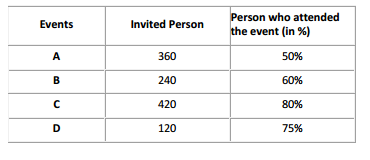Study the following information carefully and answer the given questions :
The number of cricket players in four different academies A, B, C and Dis 120, 150, 100 and 200 respectively.
There are only three types of players in a team: specialist Batsman, specialist bowlers and all-rounders (those who can both bat and ball)
Out of total number of players in academies A, B, C and D, percentage of players who can bat is 75%,80%,60%and 35% respectively.
Out of total number of players in academies A, B, C and D, percentage of players who can bowl is 50%,60%,70% and 80% respectively
Fees paid to one specialist batsman for one match is 3times the fees paid to one all-rounder for one match
Fees paid to one specialist bowler for one match is Rs20000.
Respective ratio between the fees paid to one specialist bowler for one match and the fees paid to one all-rounder for one match is 2:3.
In a team of 11 players, having 4 specialist batsmen, 4 specialist bowlers and 3 all-rounders, what is the total fees paid to the whole team together ? (in Rs lakh)
7.1
6.7
5.3
3.9
The correct Answer is:C
To solve the problem, we will break it down step by step.
Step 1: Determine the Fees for Each Type of Player
1. Specialist Bowler's Fee: Given as Rs. 20,000.
2. All-Rounder's Fee: The ratio of the fees paid to one specialist bowler and one all-rounder is 2:3. Therefore, if the bowler's fee is Rs. 20,000 (which corresponds to 2 parts), we can find the all-rounder's fee (3 parts):
All-Rounder's Fee=32×20,000=30,000
3. Specialist Batsman's Fee: It is given that the fee for one specialist batsman is three times that of one all-rounder:
Batsman's Fee=3×30,000=90,000
Step 2: Calculate Total Fees for the Team
The team consists of:
- 4 Specialist Batsmen
- 4 Specialist Bowlers
- 3 All-Rounders
Now, we will calculate the total fees for each type of player.
1. Total Fees for Batsmen:
Total Fees for Batsmen=4×90,000=360,000
2. Total Fees for Bowlers:
Total Fees for Bowlers=4×20,000=80,000
3. Total Fees for All-Rounders:
Total Fees for All-Rounders=3×30,000=90,000
Step 3: Calculate the Overall Total Fees
Now, we will add up all the fees:
Total Fees=Total Fees for Batsmen+Total Fees for Bowlers+Total Fees for All-Rounders
Total Fees=360,000+80,000+90,000=530,000
Step 4: Convert to Lakhs
Since the question asks for the total fees in lakhs:
Total Fees in Lakhs=530,000100,000=5.3 lakhs
Final Answer
The total fees paid to the whole team together is 5.3 lakhs.
---
1. Specialist Bowler's Fee: Given as Rs. 20,000.
2. All-Rounder's Fee: The ratio of the fees paid to one specialist bowler and one all-rounder is 2:3. Therefore, if the bowler's fee is Rs. 20,000 (which corresponds to 2 parts), we can find the all-rounder's fee (3 parts):
All-Rounder's Fee=32×20,000=30,000
3. Specialist Batsman's Fee: It is given that the fee for one specialist batsman is three times that of one all-rounder:
Batsman's Fee=3×30,000=90,000
The team consists of:
- 4 Specialist Batsmen
- 4 Specialist Bowlers
- 3 All-Rounders
Total Fees for Batsmen=4×90,000=360,000
Total Fees for Bowlers=4×20,000=80,000
Total Fees for All-Rounders=3×30,000=90,000
Now, we will add up all the fees:
Total Fees=Total Fees for Batsmen+Total Fees for Bowlers+Total Fees for All-Rounders
Total Fees=360,000+80,000+90,000=530,000
Since the question asks for the total fees in lakhs:
Total Fees in Lakhs=530,000100,000=5.3 lakhs
The total fees paid to the whole team together is 5.3 lakhs.
Similar Questions
The number of players in a football team is
View SolutionStudy the following diagram and answer questions based on it.
The number of Tennis players who are not Hockey players is ?
 View Solution
View SolutionStudy the following diagram and answer questions based on it .
The ratio of Hockey players to Chess players is ?
 View Solution
View SolutionStudy the following diagram and answer questions based on it.
The number of Non-Chess players is how much more than the players who play both Chess and Tennis?
 View Solution
View SolutionDirection: Study the following information carefully and answer the given questions. The table shows the total number of invited person and the percentage of person who attended the events (A, B, C, D, E) respectively.

What is the ratio of the number of persons who attended event B to the number of persons who attended the event C?View SolutionDirection: Study the following information carefully and answer the given questions. The table shows the total number of invited person and the percentage of person who attended the events (A, B, C, D, E) respectively.

What is the average of number of persons who attended the events C, D and E?View SolutionDirection: Study the following information carefully and answer the given questions. The table shows the total number of invited person and the percentage of person who attended the events (A, B, C, D, E) respectively.

Find the percentage of persons who attended the event A is how much more than the number of persons who attended the event D.View SolutionComprehension:
Study the following diagram and answer questions based on it.

The number her of tennis players who are not hockey players isView SolutionThe bar graph given below represents the number of players of a college taking part in three games for 3 years.

Total number of players in 2015 is what percent of total number of players in 2016?View SolutionStudy the following diagram and answer questions based on it .
The ratio of Hockey players to Chess players is ?
 View Solution
View Solution
